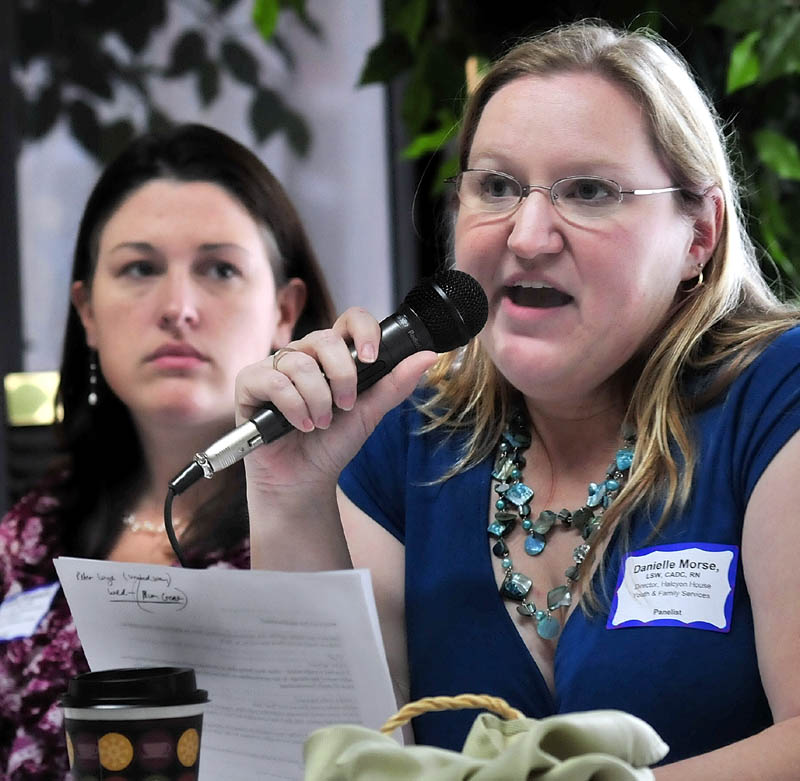WATERVILLE — Bodhi Simpson sees lots of homeless youths in her work as director of the teen parent school program at Maine Children’s Home for Little Wanderers.
“A lot of people in the community feel this is not an issue because they’re not seeing those people on the streets,” Simpson said. “Because we don’t see them doesn’t mean it’s not happening.”
Simpson was speaking Tuesday to 90 educators, social service agency representatives and homeless advocates at a forum on youth homelessness.
Simpson said some of the homeless teens seeking help from the children’s home included:
• A girl and her baby who slept for weeks in a car but could not stay at the local homeless shelter because she was not 18 or legally emancipated from her parents.
• A 16-year-old whose mother robbed a store and the teen ultimately ended up at the children’s home, nine months pregnant. She, too, was not eligible to live at the nearby homeless shelter because she was not 18. She went to live with a cousin who had five children of her own and only one bedroom.
• A teen boy who lived under a train and ultimately went to live with a girlfriend.
• A teen who walked miles with her baby in a stroller in the snow.
For Simpson, a teen shelter is needed, as well as a program that supports teens when they leave so that they can learn to care for themselves, she said.
Danielle Morse, director of Halcyon House, a teen emergency shelter in Skowhegan, said the youths come to the shelter from all walks of life. Some have been physically, sexually and mentally abused.
“These kids are labeled problem kids and that’s not really what they are,” she said.
The shelter takes in youths ages 10 to 18, and gives them shelter, food and clothing.
“We have them show up in the middle of the winter in just shorts,” she said.
The scenarios of homeless youth can be complicated. For instance, a couple has an accident, are injured, become addicted to painkillers, lose their jobs and their home, and their 14-year-old child starts to sell drugs to make money to feed the family, according to Morse.
The teen is caught, placed on probation and, still needing money, gets in trouble again and goes to a youth detention center.
The teen ultimately ends up at Halcyon House and goes back to school, Morse said, but how does one concentrate on studies when worrying about family?
“Some kids — it’s not so easy for them,” she said.
Compounding the problem are inadequate resources for homeless youth and Halcyon House is feeling the strain.
“Funding is an issue for us,” Morse said. “We just found out this week that we didn’t get our federal funding. If anybody knows of funding sources or donations, please let us know.”
Tony Veit, coordinator for Runaway and Homeless Youth Outreach Program for Youth and Family Services, said hundreds of youths are homeless in Somerset and Kennebec county in any given year. A tricky part of helping them connect with school, counseling and other services is that they often move around.
“As soon as you start moving, everything unwinds,” he said. “That is one of the big challenges — one of the reasons we really need to create stability for kids.”
Many homeless youth do not want to be labeled as such, he and others said.
Veit said he had 88 referrals for homeless youth in Somerset and Kennebec counties last year.
“It was a little up from a couple of years ago,” he said.
Yvonne Mickles, community services coordinator for Department of Health & Human Services’ Office of Child and Family Services, said she has worked on homeless issues for 20 years and recognizes that merely providing housing is not the answer — that education, mental health and substance abuse counseling and other services are critical.
She applauded the large number of people who turned out for the forum.
“We can’t end homelessness until we prevent it,” she said.
Meeting participants also brainstormed to seek the three top priorities for addressing youth homelessness. Responses included finding residential options for homeless youth; determining a better way to identify at-risk youths early on and providing them with support; assessing available resources and determining what is needed; and providing youths with trained adult mentors.
The event was downtown at The Center and was hosted by the community group, REM, United Way of Mid-Maine, and the Maine Children’s Home.
Another meeting is scheduled for 8 a.m. Nov. 15 in the REM forum room at The Center.
Amy Calder — 861-9247
acalder@centralmaine.com
Send questions/comments to the editors.




Comments are no longer available on this story